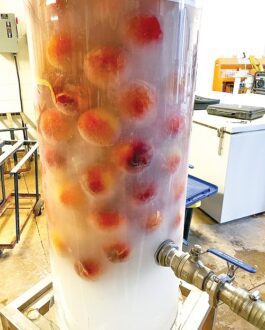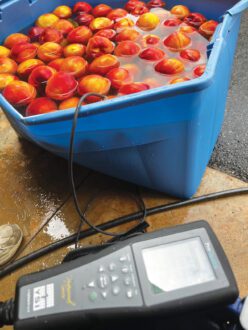Jul 10, 2023Postharvest research at UGA focuses on reducing waste
While the dilemma of how to feed a rapidly increasing population has focused primarily on how to increase yields through growing practices or improving the plant itself, a growing field of research focuses on reducing food waste.
At the University of Georgia’s (UGA) College of Agricultural and Environmental Sciences, Angelos Deltsidis is working on research projects designed to ensure that Georgia fruits, vegetables and nuts get eaten. Deltsidis, UGA professors and grad students at the Vidalia Onion Research Laboratory in Tifton, Georgia, have been testing the use of ozone to suppress disease/fungal growth on peaches, blackberries, onions and other fresh produce during short-term controlled atmosphere storage. Orestis Giannopoulos, a UGA postharvest physiology graduate student who works in the lab with Deltsidis, planned, set up and executed the ozone experiments.


Tests have also focused on ozonated water to sanitize fresh peaches prior to packing. Because ozone breaks down quickly, it is approved for use on organic crops, Deltsidis said. Peach tests have focused on gaseous and aqueous ozone. For aqueous ozone, peaches are hydrocooled in water in which ozone has been dissolved. Hydrocooling quickly after harvest eliminates shelf-life sapping heat.
The lab has hydrocooled the peaches for 30 minutes, 15 minutes and 7.5 minutes. Although the tests with aqueous ozone have been limited to batches of about 100 peaches, if the research warrants full-scale implementation, commercial hydrocoolers would be used and ozone would be used to replace water chlorination.
The facility was built in 1994 for research on controlled atmosphere (CA) storage of the famous onions, but the research now includes Georgia vegetables and fruit. Using the facility’s 15 CA storage rooms, researchers can test different concentrations of oxygen, carbon dioxide and ozone.
“(Ozone) suppresses disease growth and in general sanitizes the air or water that they (fresh fruits and vegetables) are washed in,” Deltsidis said.
Ozone, however, is highly reactive and can damage plant tissue and not just pathogens, creating a mission for the UGA postharvest physiologists.
“I work hand in hand with industry, and I do targeted projects, trials and experiments to solve issues that need a short and quick answer,” he said, “but getting a short and quick answer is very often not possible due to the complexity of live organisms.”


Deltsidis has been working on ozone research for about three years, but cautions against telling packers and shippers that ozone is an across-the-board postharvest, CA storage solution to extend shelf life for all fruits and vegetables.
“There are a lot of moving pieces in reducing food waste,” Deltsidis said. “A lot of technologies are complementary to cold storage. Some are easy, but ozone is one of the harder, very reactive treatments that can be detrimental to the supply. It doesn’t work for everything, and not a solution that can be applied for all crops.”
Almost all of Deltsidis’ research is on extending the viability of fruits and vegetables after harvest, but he’s also working with Georgia blackberry growers on a novel approach to reducing food waste: ensure that fruit varieties are well suited to Georgia’s weather and location and possess attributes consumers want. Deltsidis said it’s extremely wasteful to grow fruit that doesn’t contain the sweetness, texture, firmness, shelf llife or other characteristics that consumers desire.


is monitored for pH, temperature, electrical conductivity, dissolved oxygen and other factors.
Repeat sales are critical, and poor eating experiences will ensure lost sales, Deltsidis said. To that end, UGA researchers have used consumer tasting panels to rate what Georgia farmers have grown. A multi-year blackberry research project has documented reactions from two consumer groups last year, another one took place on June 9, followed by another in June. Deltsidis said the results should be available in August.
The 25 tasters sampled four varieties: Caddo, Osage, Ponca and Ouachita.
In part, the panels help document the effects of CA storage treatments, but they’re also designed to give growers data to make decisions about what varieties to plant. The fruit were developed in other states, so how they taste after harvest can be slightly different in Georgia, due to weather, soil and other conditions. The lab also uses gas chromatography to study the compounds and variations in the different varieties to see what’s influencing the desired traits.
“We are trying to see what our climate does to those varieties, which are the most productive, which produce best quality and good yields, and taste good,” Deltsidis said.
— Chris Koger, managing editor














